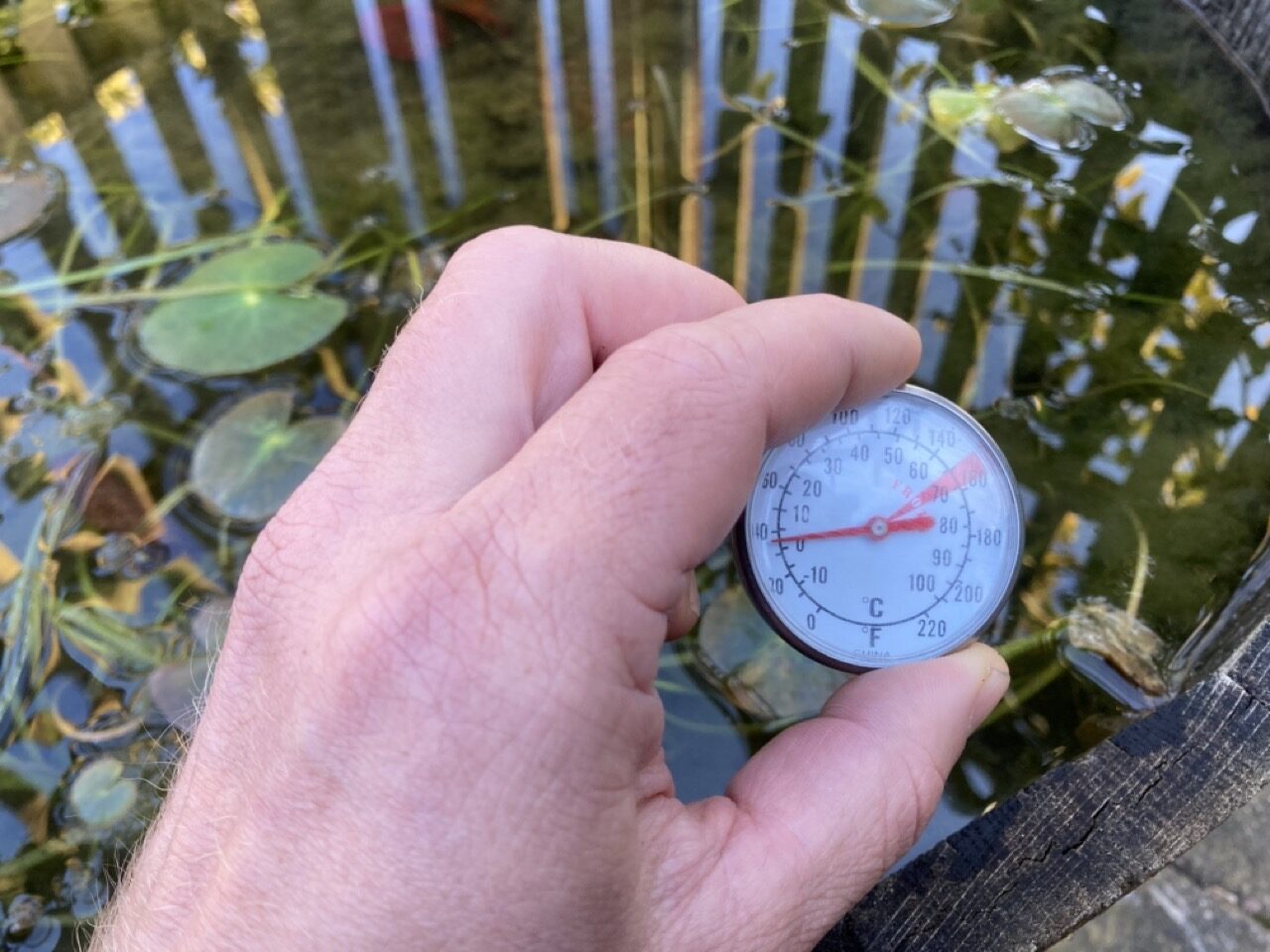In this blog post, I will delve into the significance of water temperature in a pond ecosystem and its effects on the pond’s inhabitants.
If you don’t want to read the blog post you can watch the video below.
The Seasonal Influence of water temperature on Fish Behaviour
The seasonal influence on fish behaviour is a fascinating aspect of pond ecosystems that revolves around the fluctuations in water temperature throughout the year.
During the warmer months, when water temperatures rise, fish in the pond become more active. The increased biological activity in and around the pond provides a natural abundance of food sources, including organic materials, nutrients, and tiny organisms.
I personally feed my fish very little store bought food, they can graze and hunt for food available in the pond. However, I understand that many pond owners enjoy feeding their fish, which can be a fun and enjoyable activity.
For those who choose to feed their fish, it’s essential to consider the water temperature. When the water temperature drops below 10 degrees Celsius (50°F), certain fish, such as koi and goldfish, become less efficient at metabolizing animal proteins.
Consequently, you should avoid feeding them during these colder temperatures to prevent potential health issues.
Fortunately, as the temperature decreases, so does the biological activity in the pond, and algae starts to appear. Algae, being more plant-like than animal-like, contains proteins and carbohydrates that koi and goldfish can metabolize more easily at lower temperatures, ensuring they won’t go hungry.
The behaviour of fish during the year also serves as an indicator of the pond’s health and food availability. If the fish are breeding and fry are surviving, it’s a good sign that there is an ample food supply in the pond. Conversely, if fry are not surviving, it may indicate a shortage of food resources.
It’s important to maintain a balanced fish population in the pond. Overstocking the pond can lead to competition for food and limited resources, affecting the overall health of the fish community. Native fish, which are adapted to the local climate, tend to be hardier and can better take care of themselves in the ecosystem.
In conclusion, the seasonal influence on fish behavior is a natural response to changing water temperatures and the availability of food in the pond. By understanding these patterns, pond owners can make informed decisions about feeding practices and stocking levels to ensure a healthy and thriving pond ecosystem throughout the year.
The Role of Bacteria in Pond Ecosystems
Bacteria are the unsung heroes that work tirelessly behind the scenes, breaking down organic materials and waste, contributing to the nitrogen cycle, and keeping the pond’s water quality in check.
During the warmer months, when the water temperature rises, we observe a surge in biological activity inside and outside the pond. Bacteria are busy breaking down organic materials like leaf litter, releasing vital nutrients that support plant growth and other aquatic organisms.
However, during the winter or when water temperatures drop below 10 degrees Celsius (50°F), bacterial activity slows down significantly. As a result, the breakdown of organic materials becomes much slower, leading to an accumulation of nutrients in the water. This excess of nutrients can fuel algae growth.
I have a theory about how algae growth might be influenced by the reverse nitrogen cycle due to low oxygen levels in warmer water temperatures.
As oxygen content decreases in higher water temperatures, bacteria may steal oxygen from the nitrate, which in turn encourages algae to grow by feeding on ammonia. Finding a balance between bacteria and algae is crucial for the pond’s overall health and appearance, as excessive algae can lead to green water and reduced water clarity.
I find my ponds look the best during spring and autumn. At this time, the water temperature is just right, allowing both bacteria and algae to thrive in harmony. The pond becomes visually stunning and ecologically healthy.
I find more algae tends to appear in the middle of winter and summer. Besides temperature-related factors, oxygen levels in the water can influence algae growth. Inadequate oxygen supply due to reduced water movement might result in bacteria stealing oxygen from the nitrate, further promoting algae growth.
In conclusion, bacteria are pivotal in maintaining the health and equilibrium of a pond ecosystem. Their activity, influenced by water temperature and oxygen levels, affects nutrient processing, algae growth, and overall water quality.
Understanding and managing these aspects are vital for keeping the pond thriving and balanced throughout the year.
The Impact of Oxygen Levels on Fish and Plants
Oxygen is vital for the survival and well-being of aquatic life, and understanding its significance can help us create a healthy and thriving pond ecosystem.
Fish, like all living beings, require oxygen to breathe. Different fish species obtain oxygen in different ways, but most of them rely on dissolved oxygen from the water.
As the water temperature increases, its capacity to hold dissolved oxygen decreases. This is especially important to consider during heatwaves and in smaller above-ground ponds, as oxygen levels can fluctuate more rapidly.
To ensure a pond’s oxygen levels remain optimal, it’s essential to promote water movement or agitation. Water movement helps in the oxygenation process, particularly during hot weather when oxygen demand is higher. Aerators (Amazon link) and fountains are excellent tools for maintaining sufficient oxygen levels in the pond, especially during the summer and at night.
Nighttime is particularly crucial, as plants inside the pond also consume oxygen. If you’re running a pond on solar energy without a battery system to keep the equipment running at night, you’ll want to make sure the pond is stocked with hardy fish that can tolerate lower oxygen levels.
During colder months, when water temperatures drop, oxygen levels can become a concern for fish and other aquatic life. Fish tend to congregate at the bottom of the pond, where the water is slightly warmer.
In areas where ponds freeze, it’s essential to keep a hole in the ice to allow gases to escape. This prevents dangerous gas buildup, ensuring fish have access to oxygen even in freezing conditions.
In conclusion, oxygen levels in a pond have a significant impact on fish and plants. By promoting water movement, using aerators, and ensuring aeration even during colder months, pond owners can create a healthy environment for aquatic life. Understanding the importance of oxygenation helps us maintain a balanced and thriving pond ecosystem year-round.
Preventing Stratification in Deeper Ponds
Stratification occurs when the water in a pond separates into distinct layers, with warmer water staying at the top and colder water settling at the bottom. This phenomenon can lead to various issues, such as poor water quality, low oxygen levels, and potential harm to aquatic life.
To avoid stratification, it’s crucial to ensure proper water mixing in deeper ponds.
When the water temperature rises during summer, the warmer water tends to stay on the surface, while the colder water remains at the bottom. This division restricts the circulation of oxygen and nutrients throughout the pond, affecting biological processes and promoting sludge buildup.
To combat this problem, I recommend using an aerator to thoroughly mix the water. Aerators are excellent tools that promote water movement, preventing the formation of stagnant layers and encouraging the exchange of gases between the water and the atmosphere.
By strategically placing the aerator, especially in deeper sections of the pond, we can effectively disperse the warm and cold layers, encouraging a healthy balance throughout the water column.
During winter, when ponds can freeze over in certain regions, using an aerator can also be helpful. It helps maintain an open hole in the ice, allowing gases to escape. This can be vital for the survival of fish during the colder months, as it prevents dangerous gas buildup.
When using an aerator in a deeper pond, it’s a good practice to position it a few feet off the bottom. This way, the warmer water at the bottom can mix with the cooler water at the top, promoting a healthier environment for the pond’s inhabitants.
While it’s generally not a major concern to keep the aerator at the bottom, having it positioned slightly above ensures the fish can access warmer water when needed, especially in winter.
In conclusion, preventing stratification in deeper ponds is important for maintaining a balanced and thriving pond ecosystem. The use of aerators to promote water movement and create a well-mixed environment helps avoid stagnant layers and ensures a consistent oxygen supply to fish and other aquatic organisms, including beneficial bacteria.

